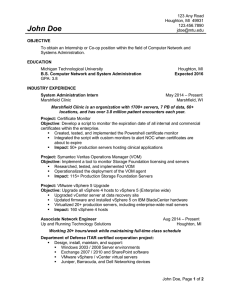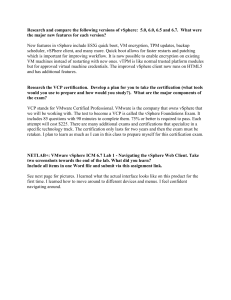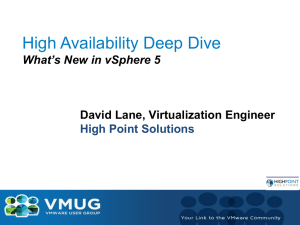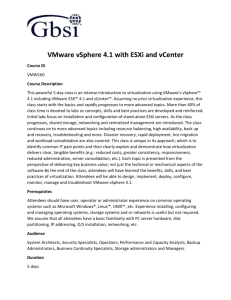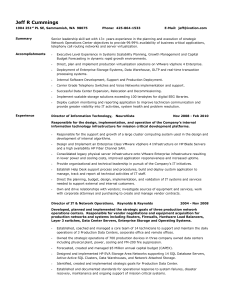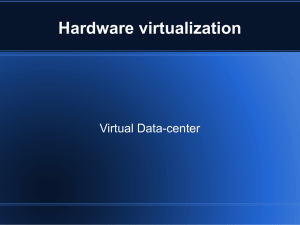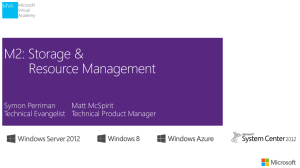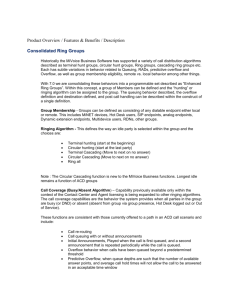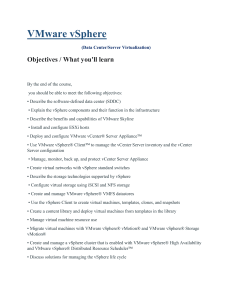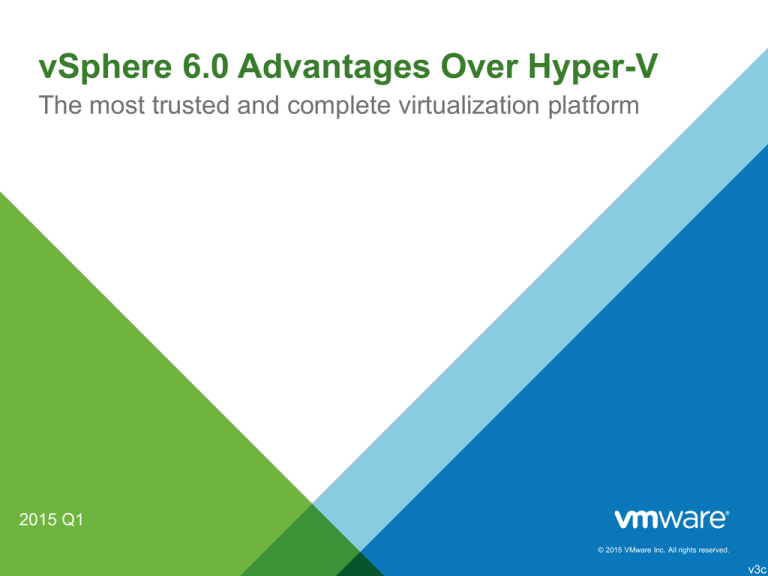
vSphere 6.0 Advantages Over Hyper-V
The most trusted and complete virtualization platform
2015 Q1
© 2015 VMware Inc. All rights reserved.
v3c
vSphere 6.0 – The Most Trusted Virtualization
Platform
vSphere 6.0
Scalability
Purpose-Built Hypervisor
Simplified Patching
Hypervisor
Architecture
Advanced Memory
Management
Long-Distance vMotion
Management Scalability
Certified Service
Providers
Broad Support
& Choice
Explicit ISV Support
Statements
Supported Operating
Systems
Host – 480 CPUs, 12TB RAM
VM – 128 vCPUs, 4TB vRAM
No reliance on general purpose OS
No unrelated patching;
Automated, image-based
with rollback capabilities
Windows Server 2012 R2 Hyper-V
Host – 320 CPUs, 4TB RAM
VM – 64 vCPUs, 1TB vRAM
~
X
Hyper-V requires
Windows Server OS
X
Subject to unrelated Windows
patching (i.e. “Update” Tuesday);
81 patches (1.9GB) required at install
Ballooning
Transparent page sharing
Memory Compression
Swap to disk/SSD; centrally managed
X
Dynamic Memory is complex and
managed on a per-VM basis with
devastating noisy-neighbor potential
NEW Long-Distance and crossvCenter vMotion capability between
remote data centers (100ms or less)
X
No comparable capability
vCenter 6.0 supports 1,000 hosts,
10,000 VMs, 64 hosts per cluster
and up to 8,000 VMs per cluster
System Center supports 1,000 hosts,
25,000 VMs, 64 hosts per cluster
and up to 8,000 VMs per cluster
7,200+ VMware Service Providers
~70,000 VMware partners globally
X
Fewer than 100 certified
CloudOS partners worldwide
3,000+ technology partners
5,000+ applications certified
~
84 fully supported operating
systems
~
Mostly just implied, not certified,
support. Apps certified on Windows
Server not always certified with Hyper-V
Full support for only 15 operating
systems
2
…to Run Business Critical Apps…
vSphere 6.0
Zero Downtime for Most
Critical Apps
Advanced Backup
Capabilities
Business
Continuity
Backup Efficiency
Live Resource Expansion
Host-Based Replication
Robust High Availability
Small Attack Surface
Area
Virtualization
Security
Centralized Security
Management
Agentless VM Protection
Fault Tolerance now supports
up to 4 vCPUs per VM
VDPA features now included in VDP:
app-consistent backups, changed
block tracking, 8TB de-duped backup
per VDP appliance, 20 VDP appliances
Windows Server 2012 R2 Hyper-V
X
Nothing comparable
X
DPM is not an appliance, requires
separate Windows and database install
with separate management, outside of
the virtual environment
X
System Center DPM requires agents
on host, limited Linux support, no
variable-length de-dupe
Hot-add vCPU, vRAM
Hot-plug/extend virtual disk
X
No hot-add vCPU
hot-extend virtual disk requires
VHDX & Gen 2 VM migration
Native vSphere Replication that also
supports vCloud Air as target, without
any VM conversion
~
Hyper-V Replica: Limited management
& monitoring. Replication to Azure may
require conversion
Single-click, withstands multiple host
failures; network and data store
heartbeats
~
Failover Clustering limited
to network heartbeat only
Built-in variable-length de-dupe
for both Windows & Linux VMs
158MB disk footprint
(actually reduced from
vSphere 5.5’s ~200MB)
X
Server Core: 5GB
Full Install: 13GB
Unified policy-based approach,
managed via vCenter
X
Lacks single interface, Requires
multiple System Center tools (VMM,
EP)
Built-in vShield Endpoint offloads AV
and anti-malware to secure appliance
X
No introspection;
Relies on agents in every VM;
legacy physical security
3
…with superior automation and management…
vSphere 6.0
Automated Storage
Workload Balancing
Intelligent Storage
Selection
Cluster-Wide Prioritization
of Storage I/O
Integrated
Storage and
Network
Management
Storage APIs
Software defined storage
Simplified VM-level
management
of storage layer
Network IO Control
Windows Server 2012 R2 Hyper-V
X
No storage DRS – Manual approach
increases the management effort
and time to provision
X
Arbitrary and manual classification of
storage devices. No compliance checks.
Storage Spaces is not VM-aware and
provides basic tiering of SSDs/HDDs only
Storage I/O Control and Storage DRS –
VM Performance isolation, prevents “noisy
neighbor” problems
~
Storage QoS provides per VM IOPS
limits but does not have any storage
awareness thus no ability to intelligently
balance storage IO across datastores
Standards-based array offload capability
reqs no additional infrastructure or config
~
Requires vendor supplied API and
additional infrastructure dependencies
X
No equivalent capability. Storage spaces
is a separate, complex physical storage
architecture with no VM visibility
Storage DRS accelerates VM placement
and reduces time to provision
Policy-Based Storage—automatic
placement on tiered storage based on
performance characteristics
VSAN integrates compute and
storage with centralized vCenter
management and VM visbility
NEW VMware Virtual Volumes (VVols)
provides storage-level granularity with
1:1 mapping of VMs to storage volumes,
simplified and automated via Storage
Policy-Based Management (SPBM).
NEW support for per-VM Distributed
vSwitch bandwidth reservations to
guarantee isolation and enforce limits
on bandwidth to ensure availability.
X
X
No equivalent capability. Storage is
managed as a separate silo of
responsibility, with no VM-level policies
Minimum throughput and VM “weight”
reservations assigned per virtual NIC
are not the same as pre-defining traffic
types and cannot guarantee isolation.
4
…at the Lowest Total Cost of Ownership.
vSphere 6.0
Automated Host
Provisioning
Automated Server
Workload Balancing
Virtual Distributed Switch
Intelligent
Automation
Automated Virtual
Networks Across NonContiguous Clusters
Content Library
High Availability
Windows Server 2012 R2 Hyper-V
Auto Deploy: Initial deployment and
ongoing host config management
X
Bare-metal provisioning via SCVMM
supports initial deployment only
Distributed Resource Scheduler and
Distributed Power Management
Optimization only looks at
~ freeDynamic
space for initial placement of VMs
Native Distributed Switch
Proven 3rd party switch
~
Native Logical Switch
First generation 3rd party switch
VXLAN
Better load balancing
~
NVGRE
no per-flow load balancing
~
SCVMM provides a single-site
VMM library but it does not have
distributed syncing and is limited
to a single managed cluster only.
X
Hyper-V Failover Clusters based on
legacy pre-virtualization model and still
risks majority node failure issue.
Complex configuration done outside
of virtualization platform. Support for
up to 64 nodes and 8,000 VMs
NEW VMware Content Library provides
centralized storage of VM templates,
vApps, ISO images and scripts that are
automatically synchronized between
vCenter servers. Easy to create VM
template and add to this library.
vSphere HA can now protect as many
as 64 ESXi hosts and 6,000 virtual
machines – up from 32 hosts and
2,048 VMs – and is still enabled by
a single checkbox in vCenter.
Remember to leverage the VMware TCO Comparison Calculator to show how
VMware provides the lowest total cost of ownership when compared to Microsoft:
http://www.vmware.com/go/tcocalculator
5

